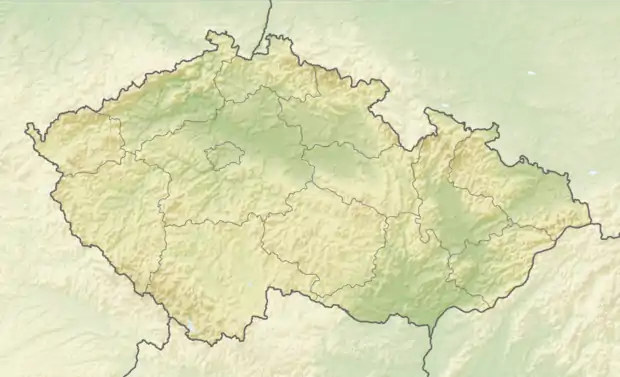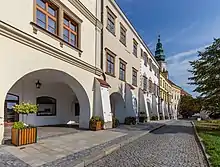Kroměříž
Kroměříž ([ˈkromɲɛr̝iːʃ] (![]() listen); German: Kremsier, Polish: Kromieryż) is a town in the Zlín Region of the Czech Republic. It has about 29,000 inhabitants.
listen); German: Kremsier, Polish: Kromieryż) is a town in the Zlín Region of the Czech Republic. It has about 29,000 inhabitants.
Kroměříž | |
|---|---|
Town | |
.jpg.webp) Town square seen from the Kroměříž Castle tower | |
 Flag  Coat of arms | |
| Nickname(s): Athens of Hanakia | |
 Kroměříž Location in the Czech Republic | |
| Coordinates: 49°17′56″N 17°23′35″E | |
| Country | |
| Region | Zlín |
| District | Kroměříž |
| Founded | 1260 |
| Government | |
| • Mayor | Jaroslav Němec |
| Area | |
| • Total | 50.97 km2 (19.68 sq mi) |
| Elevation | 201 m (659 ft) |
| Population (2020-01-01[1]) | |
| • Total | 28,620 |
| • Density | 560/km2 (1,500/sq mi) |
| Time zone | UTC+1 (CET) |
| • Summer (DST) | UTC+2 (CEST) |
| Postal code | 767 01 – 767 04; 767 07 |
| Website | www.mesto-kromeriz.cz |
| Official name | Gardens and Castle at Kroměříž |
| Criteria | ii, iv |
| Reference | 860 |
| Inscription | 1998 (22nd session) |
History

In the Middle Ages, there was a ford across the Morava and the crossroads of the Amber and Salt Roads (which was the actual continuation of the famous Silk Road). The first written record of Kromeříž dates back to 1110. On the Arab map, known as Tabula Rogeriana, the town is referred to as Agra.[2]
The settlement, inhabited by Slavs since at least the 7th century, was founded in 1260 by Bruno von Schauenburg, bishop of Olomouc. Bruno chose Kroměříž to become his see and he also made his castle the centre of his dominion, which consisted of more than 60 vassals from all over Moravia. Kroměříž is referred to as a market village in a document by Ottokar II of Bohemia from 1256, but by 1266 it was already referred to as a town. Bruno established what was to become the famous Archbishop's Palace. The town was badly damaged in the Thirty Years' War, was plundered twice by Swedish troops (1643 and 1645), and after this the Black Death took its toll on the population. Bishop Karl II von Liechtenstein-Kastelkorn rebuilt the town and the palace after that war. The Constitutive Imperial Congress sat in Kroměříž in 1848. In August 1885 a meeting took place here between the Austrian and the Russian emperors.[3]
Economy
On the outskirts of the town there is the Agricultural Research Institute Kroměříž (formerly the Research Institute of Grain, etc., founded in 1951), which is engaged in research and breeding of cereals.[4]
Sights

The town's main landmark is the Baroque Kroměříž Castle. The polygonal tower of the castle is the main landmark as well as the oldest remnant of the old Bishop's Castle.[5] The Gardens and Castle at Kroměříž were added to the list of UNESCO World Heritage Sites in 1998. In Kroměříž Castle were filmed some scenes from Amadeus and Immortal Beloved.
The Castles's Gallery has the second most significant collection of paintings in the Czech Republic and is home to The Flaying of Marsyas, a late painting by Titian.[6]
The town has two museums, Museum of Kroměříž Region and Karel Kryl's exposition.[6]
Culture
The town has traditionally held an international festival of military brass music[7] and the international festival of sacred music FORFEST.[8]
Notable people
- Jan Milíč (1320/1325–1374), ideal predecessor of Jan Hus
- Pavel Josef Vejvanovský (1633/1640–1693), baroque composer
- Heinrich Ignaz Franz Biber (1644–1704), composer and violinist
- Edmund Pascha (1714–1772), preacher, organist and composer
- Karel Josef Adolf (1715–1771), painter and restorer
- Václav Jan Frierenberger (1759–1823), general of the Napoleonic Wars
- Ferdinand Stoliczka (1838–1874), traveler, geologist, naturalist
- Max Švabinský (1873–1962), painter
- Václav Talich (1883–1961), conductor
- Jan Rypka (1886–1968), orientalist, translator
- Robert Land (1887–1942), film director
- Augustin Krist (1894–1964), football referee
- Martin Miller, (1899–1969), actor
- Josef Silný (1902–1981), footballer
- Alexej Čepička (1910–1990), communist politician
- Jaroslav Koutecký (1922–2005), chemist
- Karel Prager (1923–2001), architect
- Miloš Macourek (1926–2002), poet, playwright, screenwriter
- Milan Pitlach (born 1943), architect and photographer
- Karel Kryl (1944–1994), musician
- Boris Krajný (born 1944), pianist
- Josef Stejskal (born 1945) graphic designer, poet, surrealist
- Petr Uličný (born 1950), footballer and football manager
- Michal Peprník (born 1960), professor of American literature
- Pavel Štercl (born 1966), slalom canoeist
- Petr Štercl (born 1966), slalom canoeist
- Pavel Hapal (born 1969), footballer and football manager
- Pavel Novotný (born 1973), footballer
- Renata Berková (born 1975), triathlete
- Andrea Kalivodová (born 1977), opera singer
- Gabriela Gunčíková (born 1993), singer
- Filip Chytil (born 1999), ice hockey player
Sports
The town football club, SK Hanácká Slavia Kroměříž, plays in the Moravian-Silesian Football League, the third division of football in the Czech Republic.
Twin towns – sister cities
 Châteaudun, France
Châteaudun, France Nitra, Slovakia
Nitra, Slovakia Krems an der Donau, Austria
Krems an der Donau, Austria Piekary Śląskie, Poland
Piekary Śląskie, Poland Râmnicu Vâlcea, Romania
Râmnicu Vâlcea, Romania Ružomberok, Slovakia
Ružomberok, Slovakia
References
- "Population of Municipalities – 1 January 2020". Czech Statistical Office. 30 April 2020.
- "Zajímavé střípky z historie - Geografie a kartografie | Islam Cz". 4 November 2011. Archived from the original on 4 November 2011. Retrieved 12 September 2019.
- Chisholm, Hugh, ed. (1911). . Encyclopædia Britannica. 15 (11th ed.). Cambridge University Press. p. 925.
- "Historie společnosti" (in Czech). Zemědělský výzkumný ústav Kroměříž, s.r.o. Retrieved 16 August 2020.
- "Tips for Trips: Welcome to Kroměříž!". blog.foreigners.cz. Foreigners.cz. Retrieved 3 September 2020.
- "Muzea a galerie" (in Czech). Město Kroměříž. Retrieved 16 August 2020.
- Kuncová, Jarmila (4 September 2011). "V Kroměříži obnovili festival vojenských hudeb" (in Czech). Retrieved 12 September 2019.
- "Festival Forfest Czech Republic". forfest.cz. Retrieved 12 September 2019.
- "Partnerská města" (in Czech). Město Kroměříž. Retrieved 16 August 2020.
External links
| Wikimedia Commons has media related to Kroměříž. |